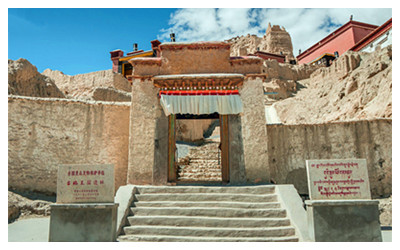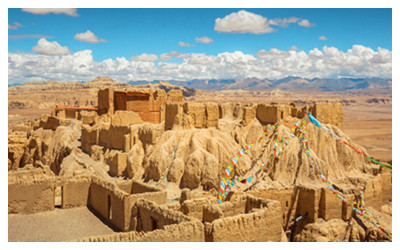- Home
- Province Guide > Tibet >
Ruins of Guge Kingdom

Guge Kingdom Ruins,located in Zanda County,
Ngari Prefecture of Tibet Autonomous Region, are the Old Summer Palace of Tibet. While these ruins were once an imperial estate which fell into disrepair after the civil revolt and the invasion of the allied armies of eight foreign countries, the Guge kingdom also encountered civil strife and foreign attacks which fragmented the once prosperous state. However, the legendary kingdom hasn't been totally lost as much can be learned about it from its remains.
Established in about the 10th century, it was founded by one branch of descendants of a nearby crumbled Kingdom. It was ruled by about 16 kings with armies of tens of thousands of soldiers during the over 700 years in which it flourished. Then in the 1660s, conflicts resulting from power disputes within the imperial family emerged which engendered restlessness in society and induced civil uprisings. To win power in the disordered state, the brother of the king asked the ruler of the neighboring country Ladakh (the present Kashmir) to send his army to help. This army overthrew and conquered the kingdom. Only years later was power returned to Tibet. During its lifetime the Guge Kingdom played an important part in the economic and cultural development of Tibet. It advocated Buddhism, and many versions of this religion were created here and their teachings were spread from here into the heart of Tibet. It also served as a major center for Tibet's foreign trade.

Guge Kingdom Ruins are famous for five temples and palaces,such as the White Temple, Red Temple, Samsara Temple, Imperial Palace and Assembly Palace. Many inscriptions, statues and murals are displayed inside these. The most complete and valuable artifacts remaining are the murals, which are mainly pictures of Sakyamuni, the king, queen, prince and other royal servants. Beside, in the sanctuary pictures of the cultivation of male and female Esoteric Buddhas can be found. The margins are painted with dozens of nude Dakinis. The colors and lines of the murals can be compared with those of the
Mogao Caves in Dunhuang City, Gansu Province. Most of the statues here are golden and silver Buddhist statues, among these the Silver Eyes of Guge is of the highest achievement.
Nowadays, the Ruins of Guge Kingdom extend around the sides of a mountain more than 300 meters high. There are over 400 rooms and 800 caves here, as well as some fortresses, secret paths, pagodas, arm storerooms, granaries and all kinds of burial places. Except for some temples, all the roofs of the rooms have collapsed, leaving only the walls. The ruins are surrounded by a city wall and a fortress marks each of the corners. Palaces, temples and local residences are distributed from the top to the bottom and only secret roads lead to the top, a layout designed to indicate the supremacy of the king and to ensure the safety of the palaces. Due to its great research value, the Ruins of Guge Kingdom have been listed under the first group of Cultural Relics of National Importance under the Protection of China.
Travel Tips
Add: 11 km from Zanda County, Ngari Prefecture of Tibet Autonomous Region
Opening Hours:09:00-19:00
Entrance Fees: CNY 50
 Guge Kingdom Ruins,located in Zanda County, Ngari Prefecture of Tibet Autonomous Region, are the Old Summer Palace of Tibet. While these ruins were once an imperial estate which fell into disrepair after the civil revolt and the invasion of the allied armies of eight foreign countries, the Guge kingdom also encountered civil strife and foreign attacks which fragmented the once prosperous state. However, the legendary kingdom hasn't been totally lost as much can be learned about it from its remains.
Guge Kingdom Ruins,located in Zanda County, Ngari Prefecture of Tibet Autonomous Region, are the Old Summer Palace of Tibet. While these ruins were once an imperial estate which fell into disrepair after the civil revolt and the invasion of the allied armies of eight foreign countries, the Guge kingdom also encountered civil strife and foreign attacks which fragmented the once prosperous state. However, the legendary kingdom hasn't been totally lost as much can be learned about it from its remains. Guge Kingdom Ruins are famous for five temples and palaces,such as the White Temple, Red Temple, Samsara Temple, Imperial Palace and Assembly Palace. Many inscriptions, statues and murals are displayed inside these. The most complete and valuable artifacts remaining are the murals, which are mainly pictures of Sakyamuni, the king, queen, prince and other royal servants. Beside, in the sanctuary pictures of the cultivation of male and female Esoteric Buddhas can be found. The margins are painted with dozens of nude Dakinis. The colors and lines of the murals can be compared with those of the Mogao Caves in Dunhuang City, Gansu Province. Most of the statues here are golden and silver Buddhist statues, among these the Silver Eyes of Guge is of the highest achievement.
Guge Kingdom Ruins are famous for five temples and palaces,such as the White Temple, Red Temple, Samsara Temple, Imperial Palace and Assembly Palace. Many inscriptions, statues and murals are displayed inside these. The most complete and valuable artifacts remaining are the murals, which are mainly pictures of Sakyamuni, the king, queen, prince and other royal servants. Beside, in the sanctuary pictures of the cultivation of male and female Esoteric Buddhas can be found. The margins are painted with dozens of nude Dakinis. The colors and lines of the murals can be compared with those of the Mogao Caves in Dunhuang City, Gansu Province. Most of the statues here are golden and silver Buddhist statues, among these the Silver Eyes of Guge is of the highest achievement. Ask Questions ?
Ask Questions ?